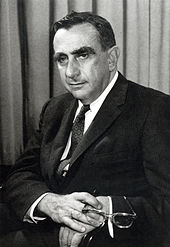Sundial (weapon)
Sundial was the codename of one of two massive nuclear bombs planned for testing by the University of California Radiation Laboratory, Livermore Branch as part of a classified[1][2] American weapons project in the early 1950s.
It was thought that the explosion would lead to an apocalyptic nuclear winter, drastically lowering global temperatures and contaminating water sources, resulting in mass fatalities.
The death toll from World War II reached some 60 million,[5][6][7] and the introduction of nuclear weapons created a new level of fear and uncertainty.
The Castle Bravo test in 1954 had a yield of 15 megatons; a thousand times more powerful than Little Boy, the bomb dropped on Hiroshima.
[4] If detonated at an altitude of 28 miles (45 km) the Sundial device could ignite fires across an area the size of France.
